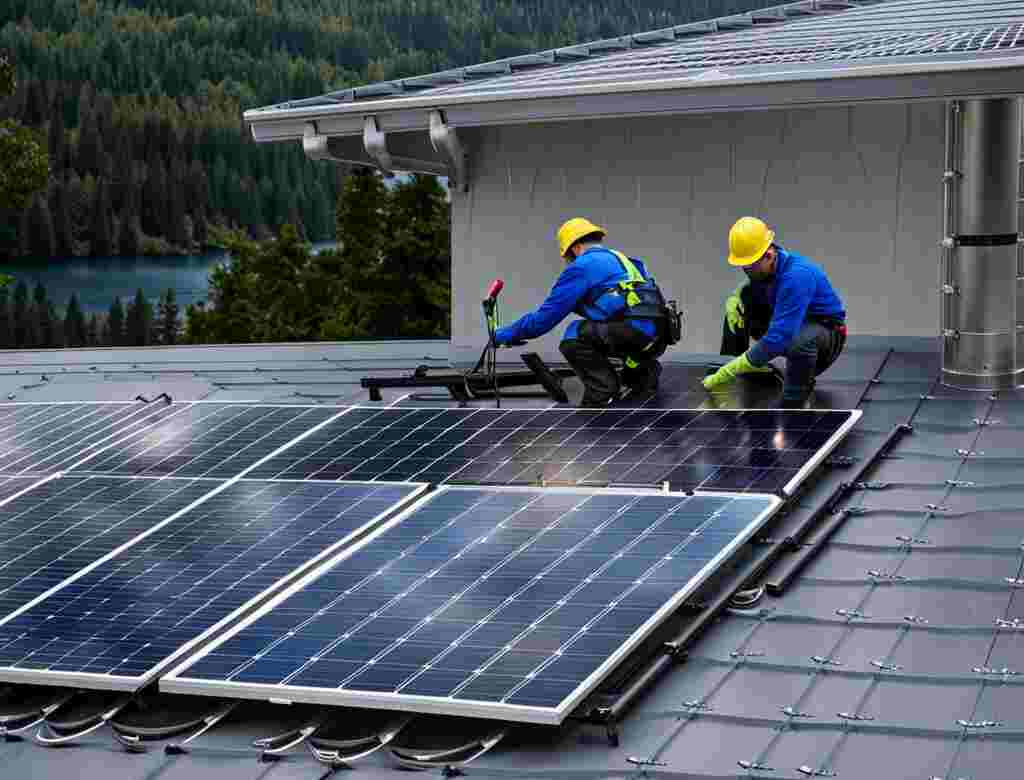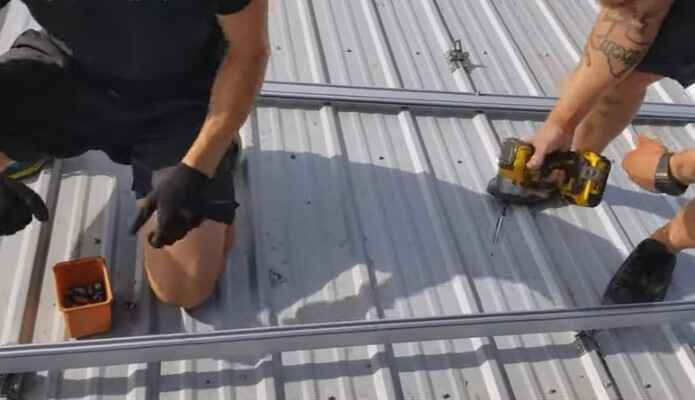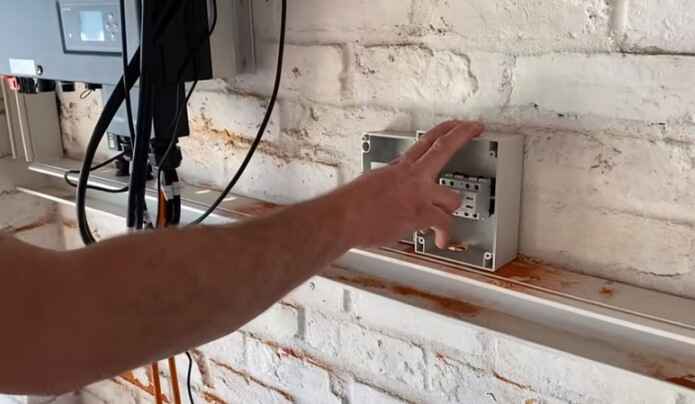As the world is moving towards a more sustainable future, solar panels have become popular for generating clean and renewable energy. However, the question arises - can solar panels be installed on a metal roof? Metal roofs are known for their durability, longevity, and ability to withstand extreme weather conditions. But can they support the weight of solar panels? In this blog post, we will explore the feasibility of installing solar panels on a metal roof, the benefits and drawbacks of doing so, and the best practices for installation. Whether you are a homeowner or a business owner, this post will help you determine if your metal roof is suitable for solar panel installation and guide you toward making an informed decision.

Metal roofs offer numerous advantages for solar panel installation and usage. Here are five of the most important benefits:
1. Durability:
Metal roofs provide long-lasting protection from all types of weather, making them an ideal choice for rooftop solar installations. Their strength and longevity make them more resistant to wear and tear than other materials, so they can withstand extreme temperatures and harsher weather conditions better than alternatives.
2. Resistance to Moisture Damage:
Metal roofing systems are highly resistant to moisture damage, a major issue when installing rooftop solar panels. The watertight seal prevents rain or snow from seeping between the panels, while their corrosion-resistant coating ensures they stay safe in wet climates.
3. Lightweight:
Metal roofs are much lighter than the alternatives, making them easier to install and maintain on rooftops. This is especially beneficial for solar panel installation as it's less of a strain on the building structure, freeing up more space for additional panels and other components.
4. Cost-Effective:
Metal roofs tend to be more cost-effective than other types of roofing systems due to their low material costs and quick installation time. This is especially helpful for large-scale solar projects where budgets are tight, and speed is essential.
5. Versatility:
Lastly, metal roofs come in a wide variety of styles, colors, and finishes that can complement different homes or businesses. This allows customers to customize the look of their rooftop solar panels to suit their tastes and preferences better. Additionally, metal roofs can be painted any color or pattern, giving them a wide range of options when it comes to installation.
These five benefits make metal roofing an ideal choice for people looking to install solar panels on their rooftops.
Considerations for Installing Solar Panels on a Metal Roof
Making the switch to solar energy is an increasingly popular choice for homeowners. Installing solar panels on a metal roof requires careful consideration to ensure optimal results and efficiency. Here are five factors to take into account:
1. Roof Strength and Condition
Ensuring structural integrity is critical for installing and functioning solar panels. The strength and condition of the underlying structure should be evaluated for any signs of corrosion or wear, which could affect the suitability of the roof for solar panel installation. Additionally, it's important to ensure the roof can withstand long-term exposure to sunlight without warping or cracking.
2. Size and Orientation
The size and orientation of the roof should be considered when planning for solar panel installation. Larger roofs can accommodate more panels, increasing the efficiency of the system. It's also important to ensure that the roof's orientation is suitable for capturing sufficient sunlight to power your home.
3. Preparation and Maintenance
Preparation is key to ensuring a successful installation and efficient operation of your solar energy system. Proper cleaning and maintenance should be regularly carried out on metal roofs with solar panels installed, as this can reduce any potential damage caused by debris or moisture buildup. Additionally, inspecting all fittings and mounting hardware periodically is important, so they remain secure over time.
4. Temperature and Ventilation
Metal roofs can get hotter than other roofing materials, so ventilation is critical to reducing the risk of overheating your solar modules. Adequate ventilation will ensure that heat is released from the roof and dissipates instead of accumulating in the system. Installing panels resistant to extreme temperatures can also help protect them against certain weather conditions.
5. Warranty and Cost
Don't forget to factor in the cost and warranty coverage for any materials or services used during the installation and operation of your solar energy system. It's important to ensure you get good value for your money by researching different suppliers and comparing prices. Additionally, ensure you understand your warranty terms to ensure any possible repairs or replacements are covered in the event of damage or malfunction.
Considering these five factors, you can be confident that your solar energy system will be properly installed and operated to its maximum potential when placed on a metal roof. Making the switch to solar has never been easier!
How to install Solar Panels on a Metal Roof?

Installing solar panels on a metal roof is possible and can effectively generate renewable energy. Here are seven steps for successful installation:
1. Preparing the Mounting System:
Before beginning installation, secure a mounting system designed for metal roofs, such as rails or clamps. Ensure that it complies with local building codes and can withstand high winds or other weather conditions in your area. Make sure the spacing between each fastener is correct for the size of the panel being used.
2. Aligning Panels Properly:
Carefully place the panels in their designated spots atop the mounting system, making sure they are correctly aligned and will provide optimal sunlight exposure. Attach securely with screws or bolts provided with the mounting system.
3. Connecting Wires:
Connect the wires to the panels and secure them in place using electrical tape or other appropriate materials. Be sure to use a voltage meter to check for any shorts or leaks before proceeding further.
4. Drilling Holes:
Drill holes into the metal roof for conduit wiring, then thread the wire through these conduits and connect them securely at both ends. Make sure that all wires are properly insulated so as not to cause an electric shock when touched.
5. Installing Inverters:
Position inverters in an area that is cooler and away from direct sunlight exposure, such as a garage or attic space, if possible. Use bolts to attach inverters securely, then connect wires to the appropriate ports on the inverter.
6. Installing Batteries:
Once the wiring is complete, install batteries in a secure location with adequate ventilation. Connect all wires before securing battery boxes with screws or bolts, and check for any shorts or leaks.
7. Install the Monitoring System:
Install a monitoring system to keep track of the electrical output of your solar panels. This will help you identify any issues and make necessary adjustments as needed.
8. Connect to Utility Grid:
Finally, connect the solar panel system to your utility grid. This will allow excess electricity your panels generate to be sent back into the grid in exchange for credits on future utility bills.
9. Testing System:
Test the entire system for voltage, amperage, and safety using a multimeter and other instruments designed for this purpose. Consult an electrician if necessary before turning on the solar power system to avoid any potential hazards or damage to property or person.
For extra protection against environmental conditions, consider applying protective coatings to metal roofs and wiring connections. With proper installation and maintenance, your metal roof solar panel system should provide energy for many years.

Common Concerns with Installing Solar Panels on a Metal Roof
Installing solar panels on a metal roof can raise concerns.
A. Damage to the Roof:
Potential Impact of Installation
The installation process itself could potentially cause damage to the roof, such as scratches or dents on its surface. Additionally, the panels' weight may be too heavy for the roof structure to support without reinforcing it first.
Long-term Deterioration
Metal roofs are often coated with materials that protect them from corrosion and rusting due to exposure to water and other elements. This protective layer could be compromised if not properly maintained during and after the installation of solar panels.
Unforeseen Issues
In some cases, unforeseen issues may arise due to solar panels, such as thermal expansion or off-gassing of volatile compounds that could damage the metal roof.
B. Interference with Roof Warranty
Voided Warranties
Depending on the type of metal roof, its warranty may be voided if solar panels are installed. This is because manufacturers may not have tested their products for compatibility with solar panels and cannot guarantee they will perform as expected.
Accessibility Issues
The manufacturer's ability to service and repair the roof could also be hindered by solar panels, as technicians may be unable to safely access all parts of the roof.
Contractual Obligations
If a warranty is still valid after the installation of a solar panel system, there may be certain contractual obligations that must be met for it to remain so. Failing to meet these obligations could lead to the voiding of a warranty.
C. Aesthetic Concerns
Visual Impact
The presence of solar panels on a metal roof may have an impact on the visual appearance of the building, which can be either positive or negative depending on personal preference.
Property Values
In some cases, installing solar panels may also affect property values in the neighborhood due to their visible presence, which could change public opinion about the area.
Other Factors
Other factors to consider when deciding whether to install solar panels on a metal roof include energy efficiency and environmental considerations such as reduced carbon emissions. These issues should be considered when considering installing solar panels' aesthetic impact.
Conclusion
In conclusion, installing solar panels on a metal roof is possible and can offer many advantages to homeowners looking to make their homes more energy-efficient. However, it's important to ensure that the metal roof is compatible with the solar panel installation and to have a professional install the panels to avoid any potential damage to the roof. Additionally, homeowners should consider factors like the angle and direction of the panels and their overall energy needs when designing their solar panel system. With proper planning and installation, homeowners can enjoy the benefits of solar energy while protecting and improving the value of their homes.
Frequently Asked Questions
Can solar panels be installed on a metal roof?
Yes, solar panels can be installed on a metal roof. Metal roofs are a suitable surface for solar panel installation and are often chosen for their durability and ease of installation. Proper mounting equipment and installation techniques are used to secure the panels to the metal roof without causing damage.
Can you install solar panels on a metal roof?
Yes, you can install solar panels on a metal roof. It's a common and viable option as long as the roof structure can support the weight of the panels and appropriate mounting hardware is used to secure them without causing leaks or damage to the roof.
How to mount solar panels on a metal roof?
To mount solar panels on a metal roof, follow these five steps:
1. Assess Roof Condition:
Inspect the metal roof for any damage or weak spots. Ensure it can support the weight of solar panels and locate roof trusses for secure attachment points.
2. Choose Mounting System:
Select a compatible solar panel mounting system. Options include rail-based, rail-less, or ballasted systems, depending on your roof type and preference.
3. Secure Mounting Brackets:
Install mounting brackets directly onto roof trusses using self-tapping screws or anchors. Ensure a watertight seal with appropriate flashing.
4. Attach Rails or Standoffs:
Depending on the chosen system, attach rails or standoffs to the mounting brackets. These will support the solar panels.
5. Install Solar Panels:
Finally, secure the solar panels onto the rails or standoffs using clamps or brackets designed for your specific panel type. Double-check the alignment and ensure all connections are secure before wiring your solar array.